SUBARU OUTBACK 2005 4.G Owners Manual
Manufacturer: SUBARU, Model Year: 2005, Model line: OUTBACK, Model: SUBARU OUTBACK 2005 4.GPages: 627, PDF Size: 6.42 MB
Page 101 of 627

1-70
Seat, seatbelt and SRS airbags
If your vehicle has sustained impact, this may affect
the proper function of the Subaru advanced frontal air-
bag system. Have your vehicle inspected at your SUB-
ARU dealer.
NOTE
The front passenger’s SRS side airbag, SRS cur-
tain airbag and seatbelt pretensioner are not con-
trolled by the Subaru advanced frontal airbag sys-tem.
!
Passenger’s frontal airbag ON and OFF indica-tors
:Front passenger’s frontal airbag ON indicator
:Front passenger’s frontal airbag OFF indicator
The front passenger’s frontal airbag ON and OFF indi-
cators show you the status of the front passenger’s
SRS frontal airbag.
The indicators are located next to the clock in the cen-
tral portion of the instrument panel.
When the ignition switch is turned to the “ON” position,
both the ON and OFF indicators illuminate for 6 sec-onds during which time the system is checked. Follow-
PASS AIR BAGPASS AIR BAGONONONOUT.DISPOFF
PASS AIR BAG
OFFON
UB3208EA
ON or
OFF or
Page 102 of 627

1-71
Seat, seatbelt and SRS airbags
– CONTINUED –
ing the system check, both indicators extinguish for 2
seconds. After this, one of the indicators illuminates
depending on the status of the front passenger’s SRS
frontal airbag reached by the Subaru advanced frontal airbag system monitoring.
If the front passenger’s SRS frontal airbag is activated,
the passenger’s frontal airbag ON indicator will illumi-
nate while the OFF indicator will remain extinguished.
If the front passenger’s SRS frontal airbag is deacti-
vated, the passenger’s frontal airbag ON indicator will
remain extinguished while the OFF indicator will illumi-
nate.
If both the ON and OFF indicators remain lit or extin-
guished simultaneously, the system is faulty. Contact
your SUBARU dealer immediately for an inspection. !Conditions in which front passenger’s SRS
frontal airbag is not activated
The front passenger’s SRS frontal airbag will not be
activated when any of the following conditions are met
regarding the front passenger’s seat: " The seat is empty.
" The seat is equipped with a rearward facing child re-
straint system and an infant is restrained with it." The seat is equipped with a forward facing child re-
straint system and a small child is restrained with it. " The seat is equipped with a booster seat and a small
child is in the booster seat. "
The seat is relieved of the occupant load for a time
exceeding the predetermined period. " The seat is occupied by a child who has outgrown a
child restraint system or a small adult." The front passenger’s occupant detection system is
faulty.
NEVER INSTALL A REARWARD FACING CHILD
SEAT IN THE FRONT PASSENGER’S SEAT
EVEN IF THE FRONT PASSENGER’S SRS
FRONTAL AIRBAG IS DEACTIVATED. Be sure
to install it in the REAR seat in a correct man-
ner. Also, it is strongly recommended that any
forward facing child seat or booster seat be in-
stalled in the REAR seat, and that even children
who have outgrown a child restraint system be
also seated in the REAR seat. This is because
children sitting in the front passenger’s seat
may be killed or severely injured should the
front passenger’s SRS frontal airbag deploy.
REAR seats are the safest place for children.
When the front passenger’s seat is occupied by a
child, observe the following precautions. Failure to do
so may increase the load on the front passenger’s
Page 103 of 627

1-72
Seat, seatbelt and SRS airbags
seat, activating the front passenger’s SRS frontal air-
bag even though that seat is occupied by a child."
Do not place any article on the seat other than the
child occupant and a child restraint system." Do not place more than one child on the seat.
" Do not install any accessory such as a table or TV
onto the seatback." Do not store a heavy load in the seatback pocket.
" Do not allow the rear seat occupant to place his/her
hands or legs on the front passenger’s seatback, or al-
low him/her to pull the seatback. " If the front passenger’s frontal airbag ON indi-
cator illuminates and the OFF indicator extin-
guishes even when an infant or a small child is
in a child restraint system (including booster
seat)
Turn the ignition switch to the “OFF” position if the
front passenger’s frontal airbag ON indicator illumi-
nates and the OFF indicator extinguishes even when
an infant or a small child is in a child restraint system
(including booster seat). Remove the child restraint
system from the seat. By referring to the child restraint
manufacturer’s recommendations as well as the child
restraint system installation procedures in the “Child
restraint systems” section in this chapter, correctly in-
stall the child restraint system. Turn the ignition switch
to the “ON” position and make sure that the front pas- senger’s frontal airbag ON indicator goes out and the
OFF indicator comes on.
If still the ON indicator illuminates while the OFF indi-
cator extinguishes, take the following actions. "
Ensure that no article is placed on the seat other
than the child restraint system and the child occupant. " Ensure that there is no article left in the seatback
pocket. " Ensure that the backward-forward position and
seatback of front passenger’s seat are locked into
place securely by moving the seat back and forth.
(Models equipped with manual seats only)
If the ON indicator still illuminates while the OFF indi-
cator extinguishes after taking relevant corrective ac-
tions described above, relocate the child restraint sys-
tem to the rear seat and immediately contact your
SUBARU dealer for an inspection.
NOTE
When a child who has outgrown a child restraint
system or a small adult is seated in the front pas-
senger’s seat, the Subaru advanced frontal airbag
system may or may not activate the front passen-
ger’s SRS frontal airbag depending on the occu-
pant’s seating posture. If the front passenger’s
SRS frontal airbag is activated (the ON indicator il-
luminates while the OFF indicator extinguishes),
Page 104 of 627

1-73
Seat, seatbelt and SRS airbags
– CONTINUED –
take the following actions. "Ensure that no article is placed on the seat other
than the occupant. " Ensure that there is no article left in the seat-
back pocket.
If the ON indicator still illuminates while the OFF
indicator extinguishes despite the fact that the ac-
tions noted above have been taken, seat the child/
small adult in the rear seat and immediately con-
tact your SUBARU dealer for an inspection. Even
if the system has passed the dealer inspection, it
is recommended that on subsequent trips the
child/small adult always take the rear seat.
Children who have outgrown a child restraint system
should always wear the seatbelt irrespective of wheth-
er the airbag is deactivated or activated. ! Conditions in which front passenger’s SRS
frontal airbag is activated
The front passenger’s SRS frontal airbag will be acti-
vated for deployment upon impact when any of the fol-
lowing conditions is met regarding the front passen-ger’s seat. " When the seat is occupied by an adult.
" When a heavy article is placed on the seat.
When the front passenger’s seat is occupied by an adult, observe the following precautions. Failure to do
so may lessen the load on the front passenger’s seat,
deactivating the front passenger’s SRS frontal airbag
despite the fact that the seat is occupied by an adult. "
Do not allow the rear seat occupant to lift the front
passenger’s seat cushion using his/her feet. " Do not place any article under the front passenger’s
seat, or squeeze any article from behind and under the
seat. This may lift the seat cushion. " Do not squeeze any article between the front pas-
senger’s seat and side trim/pillar, door or center con-
sole box. This may lift the seat cushion. " If the passenger’s frontal airbag OFF indicator
illuminates and the ON indicator extinguishes
even when the front passenger’s seat is occu-
pied by an adult
This can be caused by the adult incorrectly sitting in
the front passenger’s seat. Turn the ignition switch to
the “OFF” position. Ask the front passenger to set the
seatback to the upright position, sit up straight in the
center of the seat cushion, correctly fasten the seat-
belt, position his/her legs out forward, and adjust the
seat to the rearmost position. If the OFF indicator re-
mains illuminated while the ON indicator remains ex-
tinguished, take the following actions. " Ensure that there is no article, book, shoe, etc.
trapped under the seat, at the rear of the seat, or on
Page 105 of 627

1-74
Seat, seatbelt and SRS airbags
the side of the seat. "
Ensure that the backward-forward position and
seatback of front passenger’s seat are locked into
place securely by moving the seat back and forth.
(Models equipped with manual seats only)" Next, turn the ignition switch to the “ON” position
and let the system complete the self check. Now, the
ON indicator should illuminate while the OFF indicator
remains extinguished.
If the OFF indicator still illuminates while the ON indi-
cator remains extinguished, ask the occupant to move
to the rear seat and immediately contact your SUBA-
RU dealer for an inspection. ! Effect vehicle modifications made for persons
with disabilities may have on Subaru advanced
frontal airbag system operation (U.S. only)
Changing or moving any parts of the front seats, seat
belts, front bumper, front side frame, instrument panel,
combination meter, steering wheel, steering column,
tire, suspension or floor panel can affect the operation of the Subaru advanced airbag system. If you have
any questions, you may contact the following Subaru
distributors:
Subaru of America, Inc.
Customer Dealer Services Department P.O. Box 6000
Cherry Hill, NJ 08034-6000
1-800-SUBARU3 (1-800-782-2783)
Schuman Carriage Motors, Inc.
1234 South Beretania Street, Honolulu, HI 96814
808-592-4497
Triple J Enterprises, Inc.
P. O. Box 6066, Tamuning, Guam 96931
671-646-9126
Trebol Subaru of Puerto Rico, Inc.
P. O. Box 11204, San Juan, Puerto Rico 00910
787-793-2828
There are no Subaru distributors in any other U.S. ter-
ritories as of May 2004. If you are in such an area,
please contact the Subaru distributor or dealer from
which you bought your vehicle.
Page 106 of 627

1-75
Seat, seatbelt and SRS airbags
– CONTINUED –
!Operation
A) Driver’s side
B) Passenger’s side
The SRS airbag can function only when the ignition switch is in the “ON” position.
The Subaru advanced frontal airbag system is de-
signed to determine activation or deactivation condi-
tion of the front passenger’s SRS frontal airbag de-
pending on the total load on the front passenger’s seat
monitored by the front passenger’s occupant detection
system weight sensor. For this reason, only the driv-
er’s SRS frontal airbag may deploy in the event of a
collision, but this does not mean failure of the system.
If the front sub sensors inside both front fenders and
the impact sensors in the airbag control module detect
a predetermined amount of force during a frontal colli-
sion, the control module sends signals to the airbag
module(s) (only driver’s module or both driver’s and
front passenger’s modules) instructing the module(s)
to inflate the SRS frontal airbag(s). The driver’s and
front passenger’s SRS frontal airbags use dual stage
inflators. The two inflators of each airbag are triggered
either sequentially or simultaneously, depending on
the severity of impact, backward-forward adjustment
of the driver’s seat position and fastening/unfastening
of the seatbelt in the case of the driver’s SRS frontal
airbag and depending on the severity of impact and
the total load on the seat in the case of the front pas-
senger’s SRS frontal airbag. After the deployment, the
SRS airbag immediately start to deflate so that the
driver’s vision is not obstructed. The time required
A
B
UB1575BB
Page 107 of 627

1-76
Seat, seatbelt and SRS airbags
from detecting impact to the deflation of the SRS air-
bag after deployment is shorter than the blink of aneye.
Both when only the driver’s SRS frontal airbag deploys
and the driver’s and front passenger’s SRS frontal air-
bags deploy, the driver’s and front passenger’s seat-
belt pretensioners operate at the same time.
Although it is highly unlikely that the SRS airbag would
activate in a non-accident situation, should it occur,
the SRS airbag will deflate quickly, not obscuring vi-
sion and will not interfere with the driver’s ability to
maintain control of the vehicle.
When the SRS airbag deploys, a sudden, fairly loud
inflation noise will be heard and some smoke will be
released. These occurrences are normal result of the
deployment. This smoke does not indicate a fire in the
vehicle.
Do not touch the SRS airbag system compo-
nents around the steering wheel and dash-
board with bare hands right after deployment.
Doing so can cause burns because the compo-
nents can be very hot as a result of deployment.
Driver’s SRS frontal airbag and front passenger’s SRS
frontal airbag are designed to deploy in the event of an
accident involving a moderate to severe frontal colli-
sion. It is basically not designed to deploy in lesser
frontal impacts because the necessary protection can
be achieved by the seatbelt alone. Also, they are basi-
cally not designed to deploy in side or rear impacts or
in roll-over accidents because deployment of only the
driver’s SRS frontal airbag or both driver’s and front
passenger’s SRS frontal airbags would not help the
occupant in those situations. The driver’s and front
passenger’s SRS frontal airbags are designed to func-
tion on a one-time-only basis.
SRS airbag deployment depends on the level of force
experienced in the passenger compartment during a
collision. That level differs from one type of collision to
another, and it may have no bearing on the visible
damage done to the vehicle itself.
Page 108 of 627

1-77
Seat, seatbelt and SRS airbags
– CONTINUED –
"Examples of accident in which the driver’s/driv-
er’s and front passenger’s SRS frontal airbag(s)
will most likely deploy.
A head-on collision against a thick concrete wall at a
vehicle speed of 12 to 19 mph (20 to 30 km/h) or high-
er activates only the driver’s SRS frontal airbag or both
driver’s and front passenger’s SRS frontal airbags.
The airbag(s) will also be activated when the vehicle is
exposed to a frontal impact similar in fashion and mag-
nitude to the above-mentioned collision. "
Examples of the types of accidents in which it
is possible that the driver’s/driver’s and front
passenger’s SRS frontal airbag(s) will deploy.
The only the driver’s SRS frontal airbag or both driv-
er’s and front passenger’s SRS frontal airbags may be
UB1513BA
UB1544BA
Page 109 of 627

1-78
Seat, seatbelt and SRS airbags
activated when the vehicle sustains a hard impact in
the undercarriage area from the road surface (such as
when the vehicle plunges into a deep ditch, is severely
bumped or knocked hard against an obstacle on the
road such as a curb).
"
Examples of the types of accidents in which de-
ployment of the driver’s/driver’s and front pas-
senger’s SRS frontal airbag(s) is unlikely to de-
ploy.
There are many types of collisions which might not
UB1514BA
Page 110 of 627

1-79
Seat, seatbelt and SRS airbags
– CONTINUED –
necessarily require deployment of driver’s/driver’s and
front passenger’s SRS frontal airbag(s). If the vehiclestrikes an object, such as a telephone pole or sign
pole, or if it slides under a truck’s load bed, or if it sus-
tains an oblique offset frontal impact, the driver’s/driv-
er’s and front passenger’s SRS frontal airbag(s) may
not deploy depending on the level of accident forces involved. "
Examples of the types of accidents in which the
driver’s/driver’s and front passenger’s SRS
frontal airbag(s) will basically not deploy.
The driver’s and front passenger’s SRS frontal airbags
are designed basically not to deploy if the vehicle is
UB1515BA